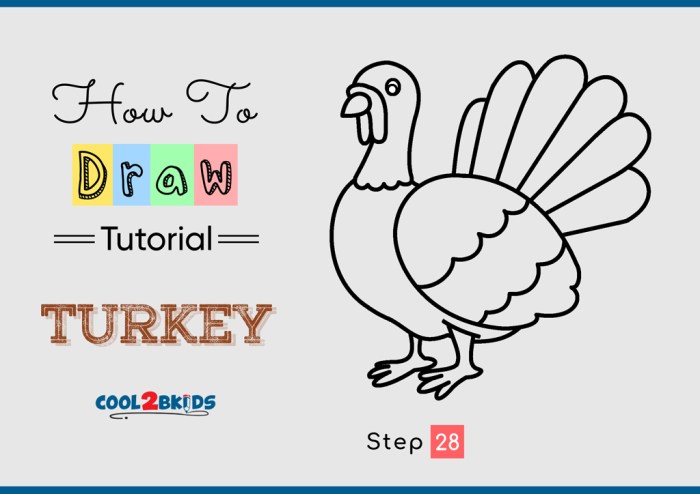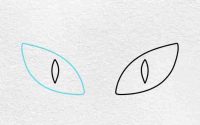Dead Turkey Drawing Easy A Total Guide
Sketching the Dead Turkey

Dead turkey drawing easy – Sketching a dead turkey, while perhaps an unusual subject, presents a unique opportunity to practice observational drawing skills. The lack of movement allows for careful study of form and texture, enhancing your understanding of anatomy and rendering techniques. This guide will break down the process into manageable steps, focusing on basic shapes and various possible poses.
Basic Shape Construction
Begin by simplifying the turkey’s form into basic geometric shapes. Imagine the body as an elongated oval, slightly wider at the breast. The neck can be represented as a curved cylinder, connecting to the head, which is a smaller, rounded oval. The legs are pairs of slightly curved cylinders tapering towards the feet. The wings, when folded, can be approximated as flattened, irregular ovals lying against the body.
Once these foundational shapes are established, you can begin to refine the details. This approach helps establish the overall proportions and posture before adding intricate features.
Poses of a Dead Turkey
A dead turkey can be depicted in several positions. It might lie on its side, with legs splayed out, perhaps one wing slightly raised. Alternatively, it might be positioned on its breast, legs tucked underneath. Another pose could show the turkey lying on its back, legs extended upwards. The head might be tilted to one side, or straight ahead.
The possibilities depend on the specific context and desired effect. Consider the perspective and how the gravity affects the limp body.
The stark lines of the dead turkey drawing felt oddly calming, a quiet contrast to the vibrant chaos I usually sought in my art. I needed a gentler subject, a softer palette, so I turned to the serene beauty of a easy japanese maple tree drawing easy tutorial for a change of pace. Returning to the turkey, I found a newfound appreciation for its simple, almost mournful elegance.
Sketching Stages: A Visual Description
Stage 1: Begin with light pencil strokes, outlining the basic shapes as described above – the oval body, cylindrical neck, smaller oval head, and cylindrical legs. These should be very loose and approximate, focusing on overall proportions and posture.Stage 2: Refine the shapes, paying attention to the curvature of the neck, the slightly pointed shape of the breast, and the way the legs bend.
Add a suggestion of the turkey’s tail feathers as a slightly fan-shaped form extending from the rear of the body. Darken the lines slightly, creating more definition.Stage 3: Begin adding details. Artikel the basic shapes of the wings, indicating the feathers with short, curved strokes. Sketch the beak and wattle, indicating the texture with short, hatched lines.
Add the feet, with their characteristic three toes in front and one behind. Lightly indicate the feathers along the neck and body with loose, directional strokes.Stage 4: Refine the details further. Add more definition to the feathers, using varying line weights to create depth and texture. Add shading to create form and volume, paying attention to the light source and how it affects the curvature of the body.
Erase unnecessary guidelines, leaving only the final drawing. The final image should display a realistic representation of a dead turkey, capturing its limp form and the subtle details of its anatomy.
Adding Details to the Dead Turkey Drawing: Dead Turkey Drawing Easy

Now that the basic structure of your dead turkey drawing is complete, it’s time to add the finer details that will bring your artwork to life—or, perhaps more accurately, to a convincingly realistic depiction of death. This stage involves focusing on the nuances of texture, feather rendering, and lighting to achieve a believable final product. Careful attention to these elements will elevate your drawing from a simple Artikel to a piece with depth and realism.Adding detail to a dead turkey drawing requires a nuanced approach to texture and shading, mimicking the subtle variations in light and shadow found in nature.
Understanding how light interacts with feathers and the turkey’s skin is crucial for achieving a sense of three-dimensionality and realism. This section will cover techniques for rendering feathers, applying appropriate shading, and depicting realistic details like the beak, wattle, and feet.
Feather Rendering Techniques, Dead turkey drawing easy
Rendering feathers accurately is paramount to creating a realistic dead turkey. Observe how feathers overlap and how light catches their individual barbs. Use short, light strokes to mimic the texture of individual feathers, varying the pressure on your pencil to create highlights and shadows. For larger areas of feathers, you might use a hatching technique, layering lines in different directions to create depth and texture.
In areas where feathers are densely packed, consider using stippling—creating a textured effect through closely spaced dots. Remember to vary the darkness and density of your shading to create a natural-looking variation in the feather’s appearance. For example, the feathers on the breast might be smoother and more tightly packed than those on the wings, requiring different shading techniques to reflect this.
Depicting Varying Lighting Conditions
The way light falls on the turkey’s plumage significantly impacts the overall realism of the drawing. Direct sunlight will create sharp highlights and deep shadows, accentuating the texture of the feathers. Consider placing a strong highlight on the areas where the light directly hits the feathers, and use darker shading in the areas where the light doesn’t reach.
Conversely, diffused light, like that found on a cloudy day, will create softer shadows and more subtle highlights, resulting in a more even tonal range. Experiment with different shading techniques to represent various lighting conditions; for instance, a spotlight from above will cast shadows beneath the turkey’s body and neck, while soft, ambient lighting will result in a more uniform distribution of light and shadow.
Realistic Depiction of Beak, Wattle, and Feet
The beak, wattle, and feet are crucial details that contribute to the overall realism of your drawing. The beak should be rendered with a smooth, slightly curved surface, incorporating highlights and subtle shading to give it a three-dimensional appearance. The wattle, a fleshy protuberance under the beak, should be depicted with a slightly textured surface, using shading to create folds and wrinkles.
The turkey’s feet are scaly and should be rendered with short, careful strokes to capture this texture. Pay close attention to the individual scales, and use shading to create depth and dimension. Remember to show the subtle variations in color and texture across these features, adding to the overall realism of the drawing. For example, the beak might have a slight sheen, while the feet might show signs of dryness or discoloration depending on the context of the scene.
Background and Composition

Setting the right background is crucial for enhancing the impact of your dead turkey drawing. The background should complement the subject, not compete with it. Consider the mood you want to evoke and the skill level you possess when making your choice. A well-chosen background can elevate a simple drawing to a truly captivating piece.The composition, or arrangement of elements within the drawing, plays a significant role in guiding the viewer’s eye and emphasizing the central subject – the dead turkey.
Strategic placement of the turkey and careful consideration of negative space will help create a visually pleasing and impactful artwork.
Background Options for a Dead Turkey Drawing
The background significantly influences the overall mood and message of the drawing. Several options offer diverse aesthetic effects. The following table compares various background choices, considering their stylistic impact, the mood they create, their relative difficulty to draw, and the appropriate skill level for attempting them.
| Style | Mood | Difficulty | Suitable Skill Level |
|---|---|---|---|
| Rustic Farm | Nostalgic, rural, perhaps slightly melancholic | Medium | Intermediate |
| Forest Floor | Darker, more mysterious, potentially emphasizing the natural cycle of life and death | Medium-High | Intermediate-Advanced |
| Simple White Background | Clean, minimalist, focuses attention directly on the turkey | Easy | Beginner |
| Abstract Background with muted colors | Subdued, artistic, allows for creative interpretation | Medium | Intermediate |
Composition Techniques to Highlight the Dead Turkey
Effective composition techniques draw the viewer’s eye to the main subject. Several approaches can be used to emphasize the dead turkey within the drawing. For instance, placing the turkey slightly off-center, rather than directly in the middle, often creates a more visually appealing composition. This is a common technique used in many art forms, from painting to photography.
The rule of thirds, a compositional guideline, can be helpful here.Another technique is to use negative space effectively. Leaving ample empty space around the turkey can make it stand out. Conversely, a cluttered background can detract from the main subject. The contrast between the turkey and the background also plays a significant role. A stark contrast, such as a dark turkey against a light background or vice-versa, will draw the viewer’s attention immediately.
Finally, the angle from which the turkey is drawn influences its perceived prominence. A slightly elevated view, for example, can create a sense of dominance or solemnity. Consider the impact of light and shadow on the turkey; strategically placed shadows can add depth and drama.
FAQ Compilation
What’s the best way to erase mistakes?
Use a kneaded eraser for precise removal of pencil marks, and a vinyl eraser for larger areas. Light strokes are your friend!
How do I make my turkey look more realistic?
Focus on details like the texture of the feathers, the subtle shading, and the realistic portrayal of the beak and wattle. Study reference photos!
Can I use this technique for other birds?
Totally! The basic principles of shape, shading, and texture apply to all birds. Just adapt the specific features to your chosen subject.
What if I’m not good at drawing?
That’s cool! Start with simple shapes and gradually add detail. Practice makes perfect, and don’t be afraid to make mistakes—they’re part of the learning process!



